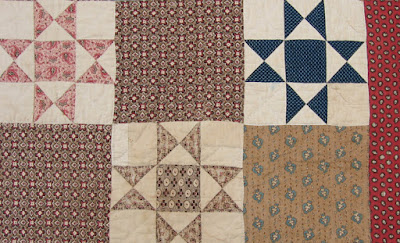Hospital Sketches Block #4: Cockscombs & Currants by Marty Webster
This month's free pattern for the Hospital Sketches BOM on my Civil War Quilts blog is Cockscombs and Currants.
1853 Elizabeth Stark,
Kansas Museum of History
Last month's classic was the Love Apple, a pattern with many variations.
Love Apple from the Virginia project book
The Cockscombs and Currants block, however, seems more cut to a pattern. The center features a circle with 8 radiating leaves or petals (usually red). A bud that fills the corners grows from four green leaves. Four curving stems grow from the circle between the leaves. Currants grow along the stems. The greatest variety is in the number of currants. In sorting through these pictures (I've got many) I see the fabrics are red and green (no pink, no chrome orange) and they are usually solids.
Watercolor of a quilt from the Works Progress Administration
project in the 1930s.
I'm surprised by how consistent the central arrangement is
with that stem fitting between the red leaves.
From the West Virginia project & the Quilt Index
It makes more design sense to me to arrange the stems like
this, growing out of a petal instead of between them.
But this format is the exception.
Block #1 & Block #4, a nice balance
I indexed quite a few in my Encyclopedia of Applique with names like Poinsettia, Oak Leaf, Grapes and Oak Leaf, and Cockscombs and Currants. Comfort magazine published the design as Chestnut Berry and Flowering Almond in the 1920s. In 1860 Elizabeth Nessly Myer described a "Flowering Almond" quilt in a letter and left
a quilt to her descendants much like the pattern here.
Flowering Almond bush
Dated 1852 from the Dixon family.
Indiana project and the Quilt Index
Dated 1853 from Ohio, online auction.
These tend to be from the years 1850-1870 with the earliest date-inscribed example in my files 1852 and two dated 1853.
An exception to the red and green rule
Well I could go on---I have dozens of photos of 19th-century examples...and a few 20th century.
From Cindy's Antique Quilts inventory
Karla Menaugh's interpretation of a 19th century arrangement.
Abiding Joy is in our Cranberry Collection book.
Abiding Joy by Karla Menaugh
90" x 90" Quilted by Lori Kukuk











































































